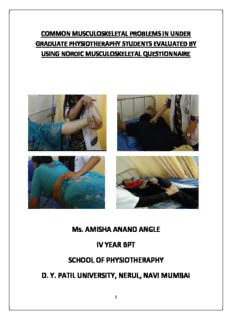
Ms. AMISHA ANAND ANGLE IV YEAR BPT SCHOOL OF PHYSIOTHERAPHY DY PATIL ... PDF
Preview Ms. AMISHA ANAND ANGLE IV YEAR BPT SCHOOL OF PHYSIOTHERAPHY DY PATIL ...
COMMON MUSCULOSKELETAL PROBLEMS IN UNDER GRADUATE PHYSIOTHERAPHY STUDENTS EVALUATED BY USING NORDIC MUSCULOSKELETAL QUESTIONNAIRE Ms. AMISHA ANAND ANGLE IV YEAR BPT SCHOOL OF PHYSIOTHERAPHY D. Y. PATIL UNIVERSITY, NERUL, NAVI MUMBAI 1 CERTIFICATE This is certify that Miss Amisha Anand Angle has satisfactorily carried out 4th year project as prescribed by the School of Physiotherapy, D.Y.Patil University, Nerul Navi Mumbai, During the academic year 2016-2017. Dr. Shweta Phadke Dr. Unnati Pandit, Associate professor Professor & Director, and guide, School of Physiotherapy School of Physiotherapy, D.Y. Patil University. D.Y.Patil University. 2 ACKNOWLEDGEMENT I take this opportunity to express my sincere gratitude to those people without whose support and concern, this project would not have been a great success. I am extremely thankful to Dr.Unnati Pandit, Head of Department of Physiotherapy of D.Y.Patil University, who has bestowed upon me her valuable advice and given me the permission to initiate the project in this institution. I am also extremely thankful to my guide, Dr. Shweta Phadke, Associate Professor of D.Y.Patil University. And last but not the least, the colleagues of our batch who deserve a word of thanks for their co-operation and all the teaching and non-teaching staff for their support and also my subjects who deserve a word of thanks for their co-operation. 3 INDEX SR.NO. TOPIC PAGE NOS. 1 INTRODUCTION 5 2 AIM AND OBJECTIVES 6 3 MATERIAL AND METHODOLOGY 7 4 DATA REPRESENTATION AND ANALYSIS 8-23 5 DISCUSSION 24-33 6 CONCLUSION 34 7 RECOMMENDATIONS 35-41 8 REFERENCES 42 9 CONSENT FORM AND QUESTIONNAIRE 43-47 4 Introduction Musculoskeletal disorders (MSDs) consist of minor physical disabilities. This term is used to describe a variety of conditions that affect the muscles, bones and joints. The severity of the musculoskeletal disorders can vary. Pain and discomfort may interfere with everyday activities. Musculoskeletal disorders are extremely common and risk increases with age. Early diagnosis is the key to ease pain while potentially decreasing further bodily damage.(1) Work-related musculoskeletal disorders (WMSDs) are a group of painful disorders of muscles, tendons and nerves. Injuries resulting from overuse and those that develop over time. Work activities which are frequent and repetitive or activities with awkward postures cause these disorders which may be painful during work or at rest. Almost all work requires the use of the arms and hands. Therefore, most work-related musculoskeletal disorders affect the hands, wrists, elbows, neck and shoulders. Work using the legs can lead to work-related musculoskeletal disorders of legs, hips, ankles and feet. Some back problems also result from repetitive activities. The Nordic Musculoskeletal Questionnaire (NMQ) was developed from a project funded by the Nordic Council of Ministers. Aim was to develop and test a standardized questionnaire methodology allowing comparison of low back, neck, shoulder and general complaints for use in epidemiological studies. The tool was not developed for clinical diagnosis. The Nordic Musculoskeletal Questionnaire can be used as a questionnaire or as a structured interview. However, significantly higher frequencies of musculoskeletal problems were reported when questionnaire was administered as part of a focused study on musculoskeletal issues and work factors than when administered as part of a periodic general health examination.(2)we are investigating musculoskeletal problems in Bachelor of Physiotherapy students using NMQ questionnaire. The students have burden of carrying books, improper posture while studying. Improper posture while taking history or treating patients can cause musculoskeletal problems. Tiredness of whole day working in hospital. . When slouching or sleeping there may be improper posture and musculoskeletal problems. At any point of time physiotherapist should have good healthy muscles which ultimately leads to strengthen the ligaments which is attached to bones. Because they have to take care of everybody’s health and to treat them. Because they tend to ignore their own problem. And they are more prone for musculoskeletal problem as they are in awkward position while treating patients. Same field interest, passion, profession. My survey will help other physiotherapists in their prevention. 5 AIMS AND OBJECTIVES AIM:- To screen work related musculoskeletal pain in students of Physiotherapy . OBJECTIVES:- To screen for body part with Chronic Pain in Physiotherapy students. To screen for body part with Acute Pain in Physiotherapy students. To screen for body part with cause of Activity Loss in Physiotherapy students . To recommend preventive strategies for pain and activity loss in Physiotherapy students . 6 MATERIAL AND METHODOLOGY Research Approach: Cross sectional survey study. Study Design: The data for this study was collected by direct interview method with help of questionnaire. Study Setting:Undergraduate Student of physiotherapy, D Y Patil University. Sample Size: 112. Inclusion Criteria: 18-21 years of age apparently healthy Bachelor of physiotherapy students from Student of physiotherapy, Dr. D Y Patil University. Exclusion: history of medical, surgical and trauma. 7 DATA REPRESENTATION AND ANALYSIS Graph 1. – Prevalence of chronic pain in 1st YEAR BPT students. 16 14 12 10 8 6 4 2 0 1ST YEAR YES LOWER BACK 15 NECK 13 UPPER BACK 12 SHOULDER 3 WRIST/HAND 3 ELBOW 1 ANKLE/FOOT 1 HIP/THIGH 0 KNEE 0 48 INFERENCE- Lower back is most affected area for chronic pain in 1st year students. 8 Graph 2. – Prevalence of acute pain in 1st YEAR BPT students. 6 5 4 3 2 1 0 1ST YEAR YES LOWER BACK 6 UPPER BACK 6 NECK 5 SHOULDER 3 ELBOW 1 WRIST/HAND 1 HIP/THIGH 0 KNEE 0 ANKLE/FOOT 0 INFERENCE- Lower back and Upper back is most affected area for acute pain in 1st year students. 9 Graph 3. – Prevalence of loss of activity pain in 1st YEAR BPT students. 7 6 5 4 3 2 1 0 1ST YEAR YES LOWER BACK 7 NECK 4 UPPER BACK 4 SHOULDER 1 ELBOW 1 WRIST/HAND 1 HIP/THIGH 1 KNEE 1 ANKLE/FOOT 1 INFERENCE- Lower back is most affected area for loss of activity pain in 1st year students. 10
Description: